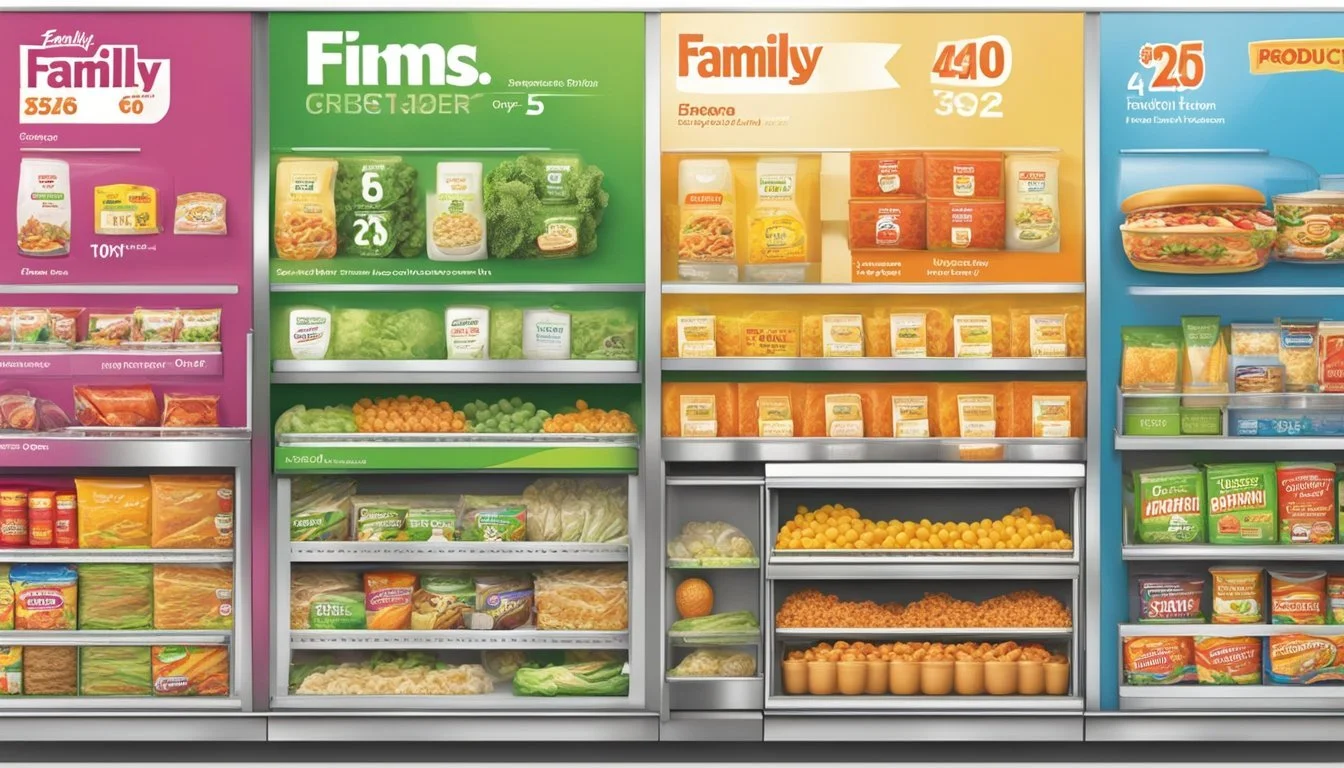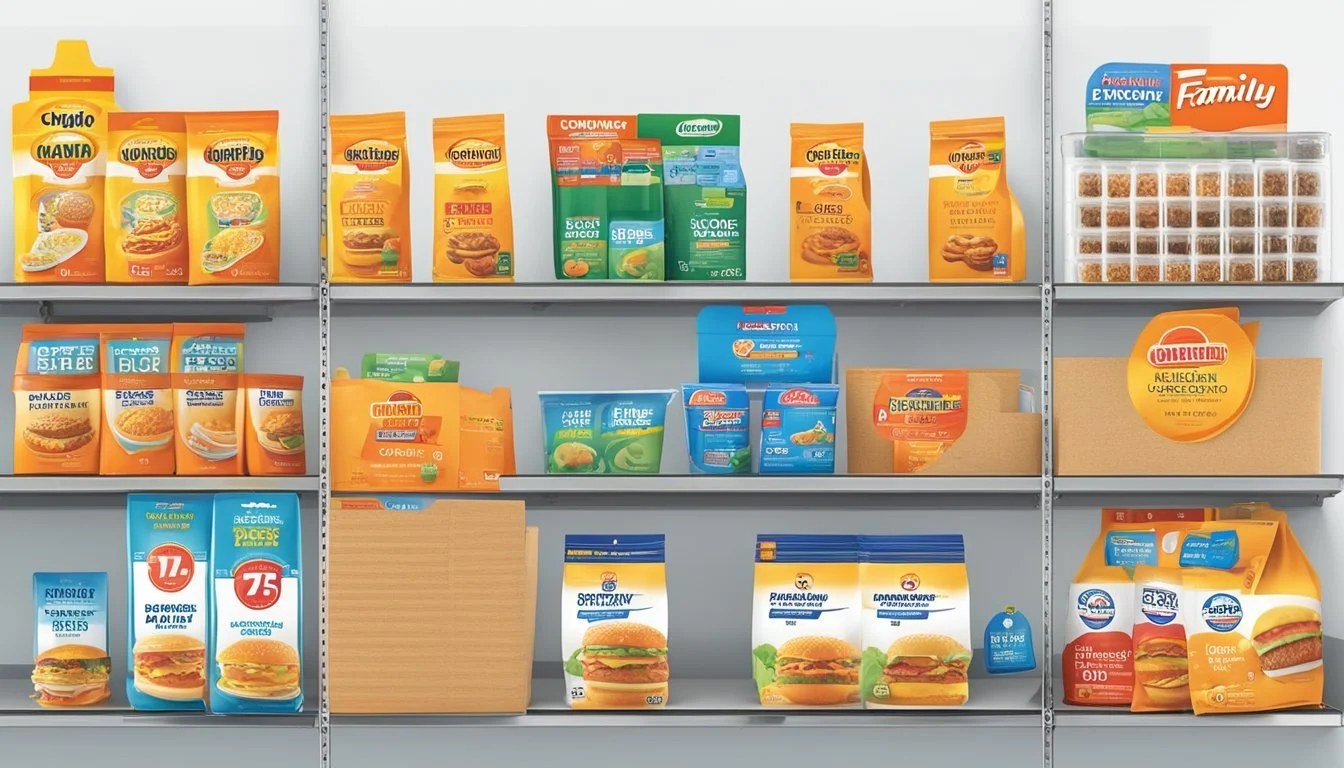Is Family Dollar Cheaper Than FoodMaxx?
A price comparison of budget retailers
Family Dollar and FoodMaxx are popular discount retailers that many consumers turn to for affordable groceries and household essentials. While both stores offer competitive prices, their product selections and pricing strategies differ. FoodMaxx typically provides lower prices on groceries compared to Family Dollar, with average savings of 15-20% on many food items.
FoodMaxx focuses primarily on groceries, offering a wide selection of fresh produce, meats, and pantry staples at discounted rates. The store operates on a no-frills model, passing savings onto customers through lower overhead costs. Family Dollar, on the other hand, carries a broader range of merchandise including clothing, home goods, and seasonal items alongside a limited grocery selection. This diverse product mix can impact overall pricing on food products.
Savvy shoppers looking to maximize their savings may find better deals on groceries at FoodMaxx, while Family Dollar can be a convenient option for picking up household essentials alongside basic food items. Consumers should compare prices on specific products they frequently purchase to determine which store offers the best value for their individual needs.
Understanding the Retail Landscape
The retail landscape has undergone significant shifts in recent years, with dollar stores expanding rapidly and traditional supermarkets adapting to changing consumer preferences. These changes have reshaped how and where people shop for groceries and household items.
The Rise of Dollar Stores
Dollar stores have experienced remarkable growth, becoming a major force in the retail sector. Family Dollar, Dollar General, and Dollar Tree have expanded their presence across the United States. These chains now offer a wide range of products, including groceries, at competitive prices.
Dollar stores often locate in areas underserved by larger retailers. This strategy has helped them capture market share from traditional supermarkets.
Many consumers appreciate the convenience and perceived value of dollar stores. These shops typically offer smaller package sizes, which can be attractive to budget-conscious shoppers.
Supermarket and Grocery Store Expansions
Traditional supermarkets have responded to the dollar store challenge by expanding their own offerings. Many now include budget-friendly store brands and bulk purchase options.
Grocery chains like FoodMaxx have focused on providing low-cost alternatives to compete with both dollar stores and larger supermarkets. They often emphasize fresh produce and a wider selection of food items.
Some supermarkets have introduced smaller format stores to compete directly with dollar stores in urban and rural areas. These stores aim to offer a more curated selection of products at competitive prices.
Consumer Shopping Behavior
Shopping habits have evolved, with many consumers now splitting their purchases between multiple store types. Price-conscious shoppers often compare prices across different retailers to find the best deals.
Convenience has become a key factor in store choice. Consumers may prefer dollar stores for quick, small purchases and supermarkets for larger shopping trips.
Online shopping and delivery services have also impacted consumer behavior. Some shoppers now supplement in-store purchases with online orders, particularly for non-perishable goods.
Store loyalty programs and digital coupons have gained popularity. These tools help consumers save money and influence their choice of where to shop.
Price Comparison Fundamentals
Comparing prices between Family Dollar and FoodMaxx requires understanding key aspects of retail pricing strategies. These include evaluating individual item costs, considering store brands, and examining bulk purchase options.
Evaluating Price Points
Price comparisons between Family Dollar and FoodMaxx start with examining individual item costs. Shoppers should focus on products they frequently purchase and compare unit prices.
For example, a 16 oz box of cereal at Family Dollar might cost $2.50, while FoodMaxx offers an 18 oz box for $2.75. By calculating the price per ounce, customers can determine which store provides better value.
It's important to note that prices can fluctuate based on location, promotions, and seasonal factors. Regular price checks help identify consistent savings opportunities.
The Role of Private Labels
Store brands play a significant role in price comparisons between Family Dollar and FoodMaxx. These private label products often offer similar quality to name brands at lower prices.
Family Dollar's Family Gourmet and FoodMaxx's First Street are examples of store brands that compete on price. Comparing these private labels can reveal substantial savings.
A 32 oz bottle of store-brand ketchup might cost $1.75 at Family Dollar, while FoodMaxx's version sells for $1.50. Such differences can add up over time for budget-conscious shoppers.
Bulk Purchases and Savings
Both Family Dollar and FoodMaxx offer bulk purchase options, which can lead to significant savings. Larger package sizes often have lower per-unit costs, benefiting customers who can store and use larger quantities.
For instance, a 4-pack of toilet paper at Family Dollar might cost $3.00, while FoodMaxx offers a 12-pack for $8.00. The larger pack at FoodMaxx provides a lower cost per roll.
Shoppers should consider storage space and product shelf life when evaluating bulk deals. Perishable items may not be cost-effective in large quantities for small households.
Product Categories and Price Analysis
Family Dollar and FoodMaxx offer diverse product ranges at competitive prices. Their pricing strategies and product quality vary across different categories, impacting overall value for shoppers.
Grocery and Non-Grocery Items
Family Dollar stocks a mix of grocery and non-grocery items. Their food selection includes canned goods, snacks, and basic pantry staples. Non-food items range from cleaning supplies to seasonal decor.
FoodMaxx focuses more heavily on groceries. They carry a wider variety of brands and package sizes for food items. Their non-grocery selection is more limited but includes essentials like paper products and pet supplies.
Price-wise, FoodMaxx often edges out Family Dollar on grocery items. Their larger quantities and focus on food products allow for better bulk pricing. Family Dollar may offer lower prices on select non-grocery items, especially in smaller sizes ideal for budget-conscious shoppers.
Fresh Produce and Meat Quality
FoodMaxx typically provides a more extensive selection of fresh produce and meat compared to Family Dollar. Their produce department offers a variety of fruits and vegetables at competitive prices.
Family Dollar's fresh offerings are usually limited to a small selection of basic produce items. They rarely stock fresh meats, focusing instead on packaged and processed options.
Quality can vary, but FoodMaxx generally maintains higher standards for freshness due to faster turnover. Their meat department often includes both budget and premium options to cater to different customer needs.
Household and Frozen Product Pricing
Family Dollar excels in household items, offering competitive prices on cleaning supplies, personal care products, and small home goods. Their selection of name-brand and generic options provides value for budget-conscious consumers.
FoodMaxx's household items section is smaller but still covers essentials. They may have slightly higher prices in this category compared to Family Dollar.
For frozen foods, FoodMaxx typically offers a wider variety and better pricing. Their larger freezer sections stock everything from basic vegetables to complete meals. Family Dollar's frozen selection is more limited, focusing on convenience items and small portions.
Both stores feature private label products in these categories, often priced lower than national brands. FoodMaxx's larger store format allows for more variety in frozen foods, potentially leading to better deals on bulk purchases.
Discount Strategies and Deals
Family Dollar and FoodMaxx employ various tactics to provide savings to their customers. These include coupons, store promotions, membership programs, and competitive pricing compared to warehouse clubs.
Coupon Usage and Store Promotions
Family Dollar offers digital and paper coupons for additional savings. Customers can stack manufacturer and store coupons to maximize discounts. The retailer frequently runs buy-one-get-one deals and dollar promotions on select items. Savvy shoppers aim for 50-60% savings when combining coupons with sales at Family Dollar.
FoodMaxx focuses on everyday low prices rather than extensive coupon programs. However, they do offer weekly specials and occasional in-store promotions. Their pricing strategy aims to provide consistent value without the need for coupons or complex deal-hunting.
Membership Discounts and Benefits
Family Dollar does not have a formal membership program. They do offer a mobile app that provides exclusive deals and digital coupons to users. The app allows customers to browse current promotions and create shopping lists.
FoodMaxx, as part of the Save Mart Companies, participates in the Save Smart Rewards program. Members earn points on purchases that can be redeemed for discounts on groceries or gas. The program provides personalized offers based on shopping habits.
Comparison with Warehouse Clubs
While warehouse clubs like Costco offer bulk savings, Family Dollar and FoodMaxx provide different value propositions. Family Dollar focuses on smaller package sizes and lower upfront costs, beneficial for budget-conscious shoppers or those with limited storage.
FoodMaxx competes by offering competitive prices on both name-brand and private-label products without requiring a membership fee. Their pricing is often 20-21% lower than average grocery stores, making them a strong alternative to warehouse clubs for regular grocery shopping.
Both retailers aim to provide savings without the annual fees associated with warehouse clubs, appealing to customers who prefer more frequent, smaller shopping trips.
Alternative Shopping Options
Budget-conscious shoppers have several options beyond Family Dollar and FoodMaxx. These alternatives cater to diverse needs and preferences, from digital convenience to specialized products and community-focused choices.
Online Retailers and Marketplaces
Amazon and other online retailers offer competitive prices on groceries and household items. Amazon Prime members enjoy additional benefits like free shipping and exclusive deals. Online marketplaces often feature a wider selection than brick-and-mortar stores.
Many online retailers provide subscription services for frequently purchased items, potentially saving customers money and time. Digital coupons and price comparison tools make it easier to find the best deals across multiple platforms.
Some online grocers specialize in bulk purchases, which can be cost-effective for large families or those who prefer to stock up.
Specialty Stores and Health Conscious Choices
Health food stores and organic markets cater to consumers seeking natural and organic products. While often perceived as more expensive, these stores frequently offer competitive prices on specialty items.
Many specialty stores have bulk sections for nuts, grains, and dried fruits, allowing customers to purchase exactly what they need. This can reduce waste and save money.
Some health-focused chains provide loyalty programs and member discounts to make healthier options more affordable. These stores often carry unique products not found in traditional supermarkets.
Local versus Chain Store Shopping
Local grocery stores may offer fresher produce and support the community economy. They often feature locally sourced products that can be competitively priced due to reduced transportation costs.
Chain stores typically have more buying power, resulting in lower prices on many items. They often provide store-brand alternatives that are cheaper than name brands.
Some local stores match prices from larger chains to remain competitive. Shopping at a mix of local and chain stores can help consumers balance cost savings with community support.
Farmers' markets present another local option, sometimes offering lower prices on seasonal produce. These markets also provide an opportunity to connect directly with food producers.
Consumer Opinions and Brand Perceptions
Family Dollar and FoodMaxx elicit distinct reactions from shoppers based on their experiences and perceptions. Price-conscious consumers weigh factors like product quality, store atmosphere, and customer service when choosing between these budget retailers.
Customer Satisfaction Surveys
Recent surveys reveal mixed opinions about Family Dollar and FoodMaxx. Family Dollar scores higher in convenience, with more locations in urban and rural areas. Customers appreciate its wide selection of household items and personal care products.
FoodMaxx earns praise for its fresh produce and meat departments. Shoppers report finding better deals on groceries compared to Family Dollar. However, some customers note inconsistent product availability at FoodMaxx stores.
Both chains receive criticism for long checkout lines and understaffing during peak hours. Family Dollar faces complaints about cluttered aisles and expired products, while FoodMaxx customers cite concerns about store cleanliness.
Brand Loyalty and Store Preferences
Brand loyalty varies between Family Dollar and FoodMaxx shoppers. Family Dollar attracts frequent small-purchase customers who value its dollar sections and seasonal items. Many rely on it for quick household essentials.
FoodMaxx cultivates loyalty through its bulk-buying options and member-only discounts. Families and budget-conscious shoppers often prefer FoodMaxx for larger grocery hauls.
Consumer researchers note that store preferences often align with shopping habits. Those prioritizing convenience tend to favor Family Dollar, while bargain hunters seeking the lowest grocery prices gravitate towards FoodMaxx.
Online reviews and shopping podcasts highlight the importance of individual store management in shaping customer experiences at both chains.
Geographic Influence on Shopping
Shopping costs and options can vary significantly based on location. Regional economic factors and store distribution impact prices and accessibility for consumers.
Regional Price Variations
Grocery prices fluctuate across different regions due to various factors. In California, for example, the cost of living tends to be higher, potentially affecting retail prices. Chains like FoodMaxx and Family Dollar may adjust their pricing strategies based on local competition and operational costs.
Urban areas often see higher prices due to increased overhead, while rural locations might have lower costs but fewer options. Stores in affluent neighborhoods sometimes charge premium prices, while those in lower-income areas may focus on budget offerings.
Accessibility and Store Location Impact
The geographic distribution of stores plays a crucial role in shopping patterns. Family Dollar typically targets rural and urban locations, making them accessible to a wide range of consumers. FoodMaxx, with fewer locations, may be less accessible in certain areas.
Distance to stores affects shopping frequency and transportation costs. Consumers in food deserts - areas with limited access to affordable, nutritious food - may rely more heavily on discount chains like Family Dollar for groceries.
Store density in a given area can influence price competition. Areas with multiple discount options often benefit from competitive pricing, while regions with limited choices may see higher prices due to reduced competition.
Future of Retail and Consumer Trends
Technological advancements and shifting consumer behaviors are reshaping the retail landscape. Predictive analytics and innovative shopping experiences are becoming increasingly important for retailers to stay competitive.
Technological Advancements in Shopping
Mobile apps and smart carts are transforming in-store experiences. Contactless payments and self-checkout options are becoming more prevalent, reducing wait times and improving efficiency.
Augmented reality (AR) allows customers to virtually try products before purchasing. This technology is particularly useful for clothing, makeup, and home decor items.
Grocery delivery options have expanded significantly. Many retailers now offer same-day delivery services through partnerships with third-party platforms or by developing their own logistics networks.
Voice-activated shopping assistants are gaining popularity. These AI-powered tools help consumers create shopping lists, place orders, and track deliveries using simple voice commands.
Predictive Consumer Spending Models
Retailers are leveraging big data to forecast consumer behavior. These models analyze past purchases, browsing history, and demographic information to predict future buying patterns.
Personalized marketing campaigns are becoming more targeted. Retailers use AI algorithms to send tailored promotions and product recommendations to individual customers.
Dynamic pricing strategies are being implemented to optimize revenue. Prices can be adjusted in real-time based on demand, competitor pricing, and inventory levels.
Subscription-based models are gaining traction in various retail sectors. These services offer regular deliveries of products, from groceries to clothing, providing convenience and predictable revenue streams for retailers.








